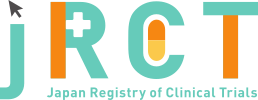臨床研究等提出・公開システム
|
May. 14, 2024 |
|
|
Jan. 30, 2025 |
|
|
jRCTs031240085 |
Clinical Trial on the Usefulness of EOI Forms in Balloom Occluded Retrograde Transvenous Obliteration Phase II |
|
Clinical Trial on the Usefulness of EOI Forms in Balloom Occluded Retrograde Transvenous Obliteration |
Kondo Takayuki |
||
Chiba University Hospital |
||
1-8-1 Inohana, Chuo Ward, Chiba City, Chiba Prefecture |
||
+81-432227171 |
||
takakon@chiba-u.jp |
||
Fujimoto Kentaro |
||
1-8-1 Inohana, Chuo Ward, Chiba City, Chiba Prefecture |
||
1-8-1 Inohana, Chuo Ward, Chiba City, Chiba Prefecture |
||
+81-432227171 |
||
fujimoto.kentarou@chiba-u.jp |
Recruiting |
May. 14, 2024 |
||
| 28 | ||
Interventional |
||
randomized controlled trial |
||
open(masking not used) |
||
active control |
||
parallel assignment |
||
treatment purpose |
||
Patients who meet all of the following criteria are eligible |
||
The following individuals are not eligible for inclusion: |
||
| 18age old over | ||
| No limit | ||
Both |
||
Portal hypertension with portal vein major circulation short circuit |
||
Study drug treatment group: BRTO with EOI form. |
||
Ratio of 5% EOI volume required for treatment to the volume of contrast agent used to delineate the portal hypervolemic short circuit on pretreatment contrast studies |
||
Technical success rate based on the evaluation by the responsible physician (assessed by contrast-enhanced CT scan after treatment). |
||
| Chiba University Hospital Startup Support Fund | |
| Not applicable |
| Chiba University Clinical Research Review Board | |
| 1-8-1 Inohana, Chuo Ward, Chiba City, Chiba Prefecture, Japan, Chiba | |
+81-43-226-2616 |
|
| prc-jim@chiba-u.jp | |
| Approval | |
April. 15, 2024 |
No |
|
none |
